Why Gorillas Are Vulnerable to Poaching
Gorillas, our closest relatives in the animal kingdom, are facing grave threats from poaching, making them increasingly vulnerable. Understanding the reasons behind this issue is crucial for conservation efforts and the future of these magnificent creatures, so let’s delve into the factors that contribute to their plight.
The Demand for Bushmeat
One of the primary drivers of gorilla poaching is the demand for bushmeat. In many regions of Central and West Africa, local communities rely on hunting wild animals for food. Unfortunately, gorillas often become targets due to their size and accessibility. As populations grow and the availability of other game diminishes, the pressure to hunt gorillas increases. This not only threatens the immediate survival of gorilla families but also disrupts the delicate balance of their ecosystems.
Illegal Wildlife Trade
Another significant factor is the illegal wildlife trade, which poses a severe risk to gorillas. These magnificent animals are not only hunted for meat but also for their body parts and young. Gorillas are viewed as status symbols, and their presence in zoos or as exotic pets can fetch high prices on the black market. This trade fuels a deadly cycle of poaching, as hunters prioritize capturing young gorillas, often orphaning them in the process. The demand for gorilla parts, such as hands or skulls, for traditional medicine or cultural practices also exacerbates the situation.
Habitat Loss and Human Encroachment
The expansion of agricultural land and human settlements compromises gorillas’ habitats, making them more susceptible to poaching. Deforestation and land development not only reduce their living space but also bring humans into closer contact with these animals, increasing the chances of poaching. As humans encroach further into gorilla territories, the likelihood of encountering and hunting these creatures rises. Efforts to clear land for farms and infrastructure can result in poachers targeting gorillas who are forced into smaller, fragmented areas where they are more easily trapped.
Conclusion
Gorillas face numerous challenges that contribute to their vulnerability to poaching, from bushmeat demand to illegal wildlife trade and habitat loss. Understanding these issues is critical in the fight for their survival. By raising awareness and supporting conservation efforts, we can all play a role in protecting these incredible animals. If you’re interested in making a difference, consider learning more about gorilla conservation and supporting organizations dedicated to this cause. Together, we can help ensure a future where gorillas thrive in their natural habitats.

